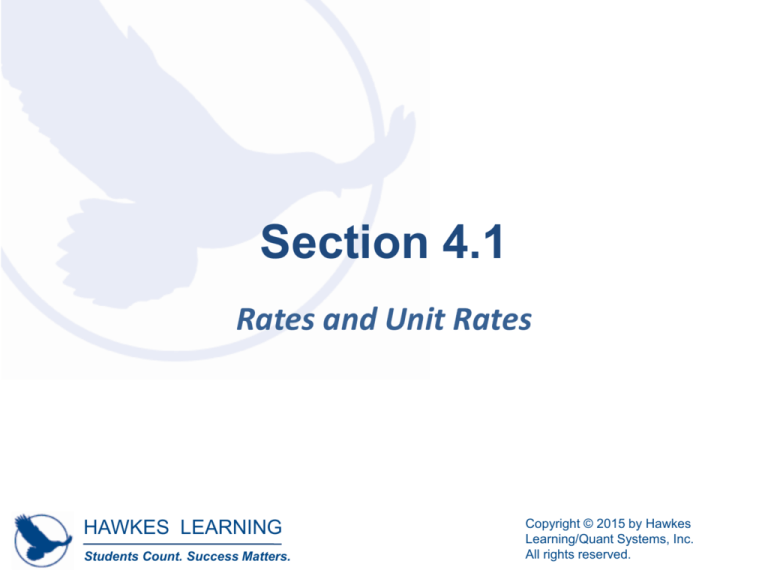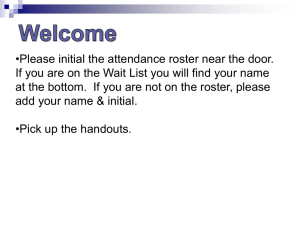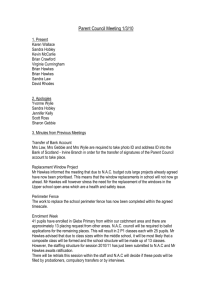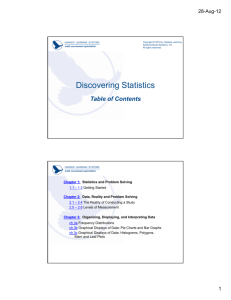
Section 4.1
Rates and Unit Rates
HAWKES LEARNING
Students Count. Success Matters.
Copyright © 2015 by Hawkes
Learning/Quant Systems, Inc.
All rights reserved.
Objectives
o Write rates as fractions
o Solve proportional equations
o Calculate unit rates
HAWKES LEARNING
Students Count. Success Matters.
Copyright © 2015 by Hawkes
Learning/Quant Systems, Inc.
All rights reserved.
Rate
Rate
A rate is a fraction used to compare two quantities that
are not necessarily in the same units.
HAWKES LEARNING
Students Count. Success Matters.
Copyright © 2015 by Hawkes
Learning/Quant Systems, Inc.
All rights reserved.
Example 1: Writing Rates
Suppose you and your friends are deciding where to
spend Friday night. Laser tag offers the following deals:
$13.00 per person for 2 games or $18.00 per person for
3 games. However, the county fair is offering $20.00
wristbands allowing all-you-can-ride access for the
night. Since both options sound appealing, you let your
friends decide where to spend the evening. To make
the decision easier, you would like to present them
with rates for the evening’s choices based on time.
HAWKES LEARNING
Students Count. Success Matters.
Copyright © 2015 by Hawkes
Learning/Quant Systems, Inc.
All rights reserved.
Example 1: Writing Rates (cont.)
Write down a rate for each choice based on time if it
takes 30 minutes to play a game of laser tag or if you
could stay at the fair from 8 p.m. until 10 p.m.
Solution
Since we are asked to write rates based on time, we will
write each option as a fraction with price in the
numerator of the fraction and time in the denominator.
price
time
HAWKES LEARNING
Students Count. Success Matters.
Copyright © 2015 by Hawkes
Learning/Quant Systems, Inc.
All rights reserved.
Example 1: Writing Rates (cont.)
Consider the laser tag option first. If it takes 30 minutes
to play one game of laser tag, the denominator is
calculated by multiplying the number of games played
by 30.
$13
$13
Laser Tag Deal 1:
2 30 min 60 min
$18
$18
Laser Tag Deal 2:
3 30 min 90 min
HAWKES LEARNING
Students Count. Success Matters.
Copyright © 2015 by Hawkes
Learning/Quant Systems, Inc.
All rights reserved.
Example 1: Writing Rates (cont.)
For the fair, the rate will be based on staying at the fair
from 8 p.m. until 10 p.m., which is 2 hours of unlimited
rides.
$20
Fair:
2 hours
HAWKES LEARNING
Students Count. Success Matters.
Copyright © 2015 by Hawkes
Learning/Quant Systems, Inc.
All rights reserved.
Example 2: Identifying Rates
Foods in Bulk offers 30 pounds of candy for $64.49 on
its website. Which of the following fractions represents
the rate given by their website?
1
30 lb
30 lb
$64.49
a.
b.
c.
d.
$64.49
$64.49
1
30 lb
HAWKES LEARNING
Students Count. Success Matters.
Copyright © 2015 by Hawkes
Learning/Quant Systems, Inc.
All rights reserved.
Example 2: Identifying Rates (cont.)
Solution
There are actually two correct ways to write the rate
from the website: answers b. and d. You can either
write the fraction in pounds of candy per price in
dollars like answer b., or price in dollars per pounds of
candy like answer d. Both a. and c. are incorrect
because neither compares the amount of candy to the
price of the candy.
HAWKES LEARNING
Students Count. Success Matters.
Copyright © 2015 by Hawkes
Learning/Quant Systems, Inc.
All rights reserved.
Example 3: Working with Miles per Gallon
As a college graduation present, Katie’s parents helped
her buy her first new vehicle. She chose one that claims
a fuel efficiency of 29 miles per gallon (mpg) on the
highway. Check the actual mpg on Katie’s new car if she
drove 309 miles on 11 gallons of gas.
HAWKES LEARNING
Students Count. Success Matters.
Copyright © 2015 by Hawkes
Learning/Quant Systems, Inc.
All rights reserved.
Example 3: Working with Miles per Gallon
(cont.)
Solution
Begin by setting up a ratio of the actual miles Katie
drove on 11 gallons of gas. We’ll put the gallons in the
denominator so that we can have a comparison of the
actual mpg to the manufacturer’s mpg.
309 miles
11 gallons
HAWKES LEARNING
Students Count. Success Matters.
Copyright © 2015 by Hawkes
Learning/Quant Systems, Inc.
All rights reserved.
Example 3: Working with Miles per Gallon
(cont.)
The question asks how many miles did she drive on 1
gallon? We can simply divide here to find that, as
follows.
309 miles
28.09 mpg
11 gallons
Whether or not Katie drove all 309 miles on the
highway, she still managed to get close to the
manufacturer’s mpg rate of 29 mpg.
HAWKES LEARNING
Students Count. Success Matters.
Copyright © 2015 by Hawkes
Learning/Quant Systems, Inc.
All rights reserved.
Skill Check #1
Skill Check #1
If rice costs $7.99 for 5 pounds, determine the cost per
pound of the rice.
Answer: $1.598 per pound
HAWKES LEARNING
Students Count. Success Matters.
Copyright © 2015 by Hawkes
Learning/Quant Systems, Inc.
All rights reserved.
Proportional Equation
Proportional Equation
A proportional equation consists of two rates set equal
to one another.
HAWKES LEARNING
Students Count. Success Matters.
Copyright © 2015 by Hawkes
Learning/Quant Systems, Inc.
All rights reserved.
Example 4: Using Proportional Equations
How much gasoline should Katie have used after
driving 243 miles in her new car that boasts 29 mpg?
Set up and use a proportional equation to find the
answer.
Solution
Begin by setting up the miles per gallon rate that was
claimed by the manufacturer as a fraction. Remember
to put miles in the numerator and gallons in the
denominator.
29 miles
1 gallon
HAWKES LEARNING
Students Count. Success Matters.
Copyright © 2015 by Hawkes
Learning/Quant Systems, Inc.
All rights reserved.
Example 4: Using Proportional Equations (cont.)
We need to find an equivalent fraction that has 243
miles in the numerator rather than 29 miles. We can
use a variable, such as x, to represent the number of
gallons of gasoline used for 243 miles. That gives us the
rate of
243 miles
.
x gallons
HAWKES LEARNING
Students Count. Success Matters.
Copyright © 2015 by Hawkes
Learning/Quant Systems, Inc.
All rights reserved.
Example 4: Using Proportional Equations (cont.)
Now we can set the two rates equal to one another to
form a proportional equation. Note that both rates are
in the same form, with miles in the numerator and
gallons in the denominator.
29 miles 243 miles
1 gallon
x gallons
HAWKES LEARNING
Students Count. Success Matters.
Copyright © 2015 by Hawkes
Learning/Quant Systems, Inc.
All rights reserved.
Example 4: Using Proportional Equations (cont.)
To solve a proportional equation like this, recall that we
use algebra to isolate the unknown quantity x. In other
words, we want to get x on one side of the equation by
itself. Begin by multiplying both sides of the equation
by each of the denominators in order to remove the
fractions. In this case, multiply by 1x, or simply x.
HAWKES LEARNING
Students Count. Success Matters.
Copyright © 2015 by Hawkes
Learning/Quant Systems, Inc.
All rights reserved.
Example 4: Using Proportional Equations (cont.)
29 243
1
x
29
243
x
x
1
x
29x 243
29 x 243
29
29
x 8.38
So, Katie should have used approximately 8.38, or
about 8 13 , gallons of gas after driving 243 miles.
HAWKES LEARNING
Students Count. Success Matters.
Copyright © 2015 by Hawkes
Learning/Quant Systems, Inc.
All rights reserved.
Unit Rate
Unit Rate
A unit rate is a rate comparing two measured
quantities, one of which is a single unit written in the
denominator of the fraction.
HAWKES LEARNING
Students Count. Success Matters.
Copyright © 2015 by Hawkes
Learning/Quant Systems, Inc.
All rights reserved.
Example 5: Finding Unit Rates
Find the unit rate for each of the following types of
wood mulch at the local garden center.
a. Pine bark mulch: $3.77 for 3 cubic feet
b. Aromatic cedar mulch: $3.98 for 2 cubic feet
c. Evergreen red mulch: $3.33 for 2 cubic feet
Solution
To find the unit rates for each mulch, we first set up
price
each rate as a fraction; that is,
.
amount
HAWKES LEARNING
Students Count. Success Matters.
Copyright © 2015 by Hawkes
Learning/Quant Systems, Inc.
All rights reserved.
Example 5: Finding Unit Rates (cont.)
$3.77
a. Pine bark mulch: $3.77 for 3 cubic feet
3 cubic feet
b. Aromatic cedar mulch: $3.98 for 2 cubic feet
$3.98
2 cubic feet
c. Evergreen red mulch: $3.33 for 2 cubic feet
$3.33
2 cubic feet
HAWKES LEARNING
Students Count. Success Matters.
Copyright © 2015 by Hawkes
Learning/Quant Systems, Inc.
All rights reserved.
Example 5: Finding Unit Rates (cont.)
Now that we have a rate for each type of mulch, we
need to convert them to unit rates. To do this, we
divide both parts of the fraction by the amount in the
denominator.
a. Pine bark mulch:
$1.26
$3.77 3
or $1.26 per cubic foot
3 cubic feet 3 1 cubic foot
HAWKES LEARNING
Students Count. Success Matters.
Copyright © 2015 by Hawkes
Learning/Quant Systems, Inc.
All rights reserved.
Example 5: Finding Unit Rates (cont.)
b. Aromatic cedar mulch:
$3.98 2
$1.99
or $1.99 per cubic foot
2 cubic feet 2 1 cubic foot
c. Evergreen red mulch:
$3.33 2
$1.67
or $1.67 per cubic foot
2 cubic feet 2 1 cubic foot
Once converted to unit rates, we can see that the pine
bark mulch is the least expensive mulch in our list.
HAWKES LEARNING
Students Count. Success Matters.
Copyright © 2015 by Hawkes
Learning/Quant Systems, Inc.
All rights reserved.
Skill Check #2
Skill Check #2
Helium gas (He) was placed in a container fitted with a
porous membrane. The helium effused through the
membrane at the rate of 1.5 L/24 hr. Find the unit rate
of effusion per hour for the helium.
Answer: 0.0625 L/1 hr
HAWKES LEARNING
Students Count. Success Matters.
Copyright © 2015 by Hawkes
Learning/Quant Systems, Inc.
All rights reserved.
Example 6: Using Unit Rates
Emma is traveling to Italy for spring break. She is
preparing herself for all the shopping she has planned
by looking at the exchange rate between dollars and
euros. To ensure that she does not overspend while
there, she wants to have in mind the equivalent dollar
amounts for euro prices. Table 1 shows a section of the
exchange rates that Emma found listed on the Internet.
HAWKES LEARNING
Students Count. Success Matters.
Copyright © 2015 by Hawkes
Learning/Quant Systems, Inc.
All rights reserved.
Example 6: Using Unit Rates (cont.)
EURO vs.
Table 1: Exchange Rates
1 EUR
in EUR
American Dollar
Argentine Peso
Brazilian Real
1.351
5.62251
2.2542
0.740192
0.177856
0.443617
British Pound
Canadian Dollar
0.8419
1.3328
1.18779
0.7503
HAWKES LEARNING
Students Count. Success Matters.
Copyright © 2015 by Hawkes
Learning/Quant Systems, Inc.
All rights reserved.
Example 6: Using Unit Rates (cont.)
a. What is the unit exchange rate for American dollars
to euros?
b. What is the unit exchange rate for euros to
American dollars?
c. If Emma is considering taking $200 for spending
money, approximately how many euros will she
have to spend?
HAWKES LEARNING
Students Count. Success Matters.
Copyright © 2015 by Hawkes
Learning/Quant Systems, Inc.
All rights reserved.
Example 6: Using Unit Rates (cont.)
d. Once in Italy, Emma falls in love with a leather bag
priced at €200. She knows that it is over her budget,
but wants to know by how much. Use the exchange
rate to find out approximately how much the bag
would cost in American dollars.
HAWKES LEARNING
Students Count. Success Matters.
Copyright © 2015 by Hawkes
Learning/Quant Systems, Inc.
All rights reserved.
Example 6: Using Unit Rates (cont.)
Solution
a. The format of the table is very similar to many
others you will find online. Reading it correctly is
half the battle. The column labeled “1 EUR” gives
the amount of corresponding currency that would
be equivalent to one euro. If we want a rate of
American dollars to euros, the unit rate for euros
should be in the denominator.
dollars ?
euros 1
HAWKES LEARNING
Students Count. Success Matters.
Copyright © 2015 by Hawkes
Learning/Quant Systems, Inc.
All rights reserved.
Example 6: Using Unit Rates (cont.)
Reading down the first column, we can see that there
are 1.351 dollars for each euro. We have
dollars $1.351
.
euros
€1
HAWKES LEARNING
Students Count. Success Matters.
Copyright © 2015 by Hawkes
Learning/Quant Systems, Inc.
All rights reserved.
Example 6: Using Unit Rates (cont.)
b. This time we need the rate for euros to American
dollars, so the dollar amount will be in the
denominator. The second column labeled “in EUR”
provides the number of euros equivalent to one unit
of currency listed. Therefore, we have
euros €0.740192
.
dollars
$1
HAWKES LEARNING
Students Count. Success Matters.
Copyright © 2015 by Hawkes
Learning/Quant Systems, Inc.
All rights reserved.
Example 6: Using Unit Rates (cont.)
c. To answer this question, we will set up a
proportional equation to solve. We know that Emma
has $200 and wants to know the equivalent amount
of euros. Writing a rate with the unknown amount
of euros as x gives us
$200
.
€x
We can use the dollars/euros unit rate we found in
part a. to set up a proportional equation.
$200 $1.351
€x
€1
HAWKES LEARNING
Students Count. Success Matters.
Copyright © 2015 by Hawkes
Learning/Quant Systems, Inc.
All rights reserved.
Example 6: Using Unit Rates (cont.)
Solving for x, we have the following.
200
1.351
x
x
x
1
200 1.351x
x 148.04
So, Emma will have approximately €148 to spend on
her trip to Italy.
HAWKES LEARNING
Students Count. Success Matters.
Copyright © 2015 by Hawkes
Learning/Quant Systems, Inc.
All rights reserved.
Example 6: Using Unit Rates (cont.)
d. In this situation, we want to change from euros to
dollars. We can set up a proportional equation as
we did in part c. and solve it. This time, however, we
will use the unit rate found in part b., euros per
dollar, since we are given euros to begin with. The
unit rate found in part b. is
€0.740192
.
$1
HAWKES LEARNING
Students Count. Success Matters.
Copyright © 2015 by Hawkes
Learning/Quant Systems, Inc.
All rights reserved.
Example 6: Using Unit Rates (cont.)
Setting up a proportional equation using €200 and x as
the equivalent amount in dollars gives us
€0.740192 €200
.
$1
$x
Solving for x we have the following.
0.740192
200
x
x
1
x
0.740192x 200
x 270.20
HAWKES LEARNING
Students Count. Success Matters.
Copyright © 2015 by Hawkes
Learning/Quant Systems, Inc.
All rights reserved.
Example 6: Using Unit Rates (cont.)
This means that the leather bag costs $270.20 (in
American dollars). Since her original budget was $200,
buying this bag would put her approximately $70 over
her budget.
HAWKES LEARNING
Students Count. Success Matters.
Copyright © 2015 by Hawkes
Learning/Quant Systems, Inc.
All rights reserved.




